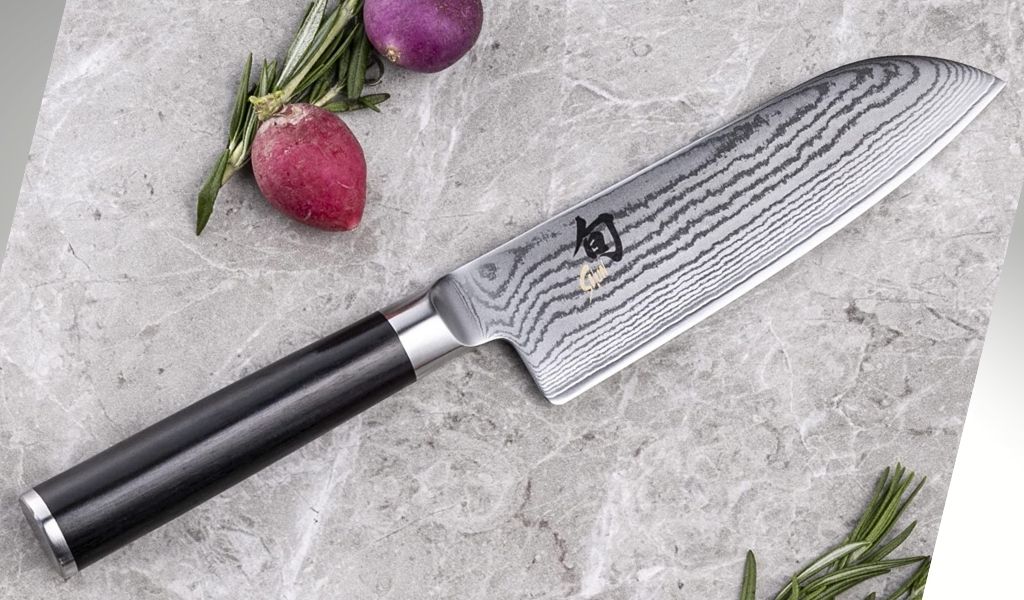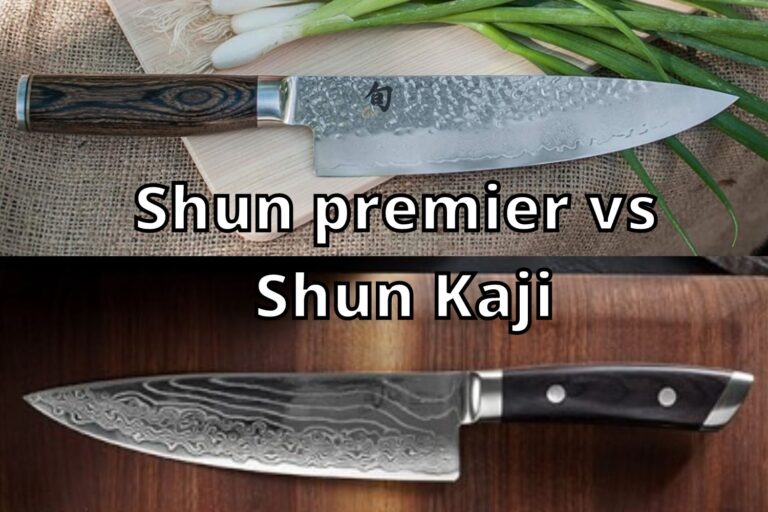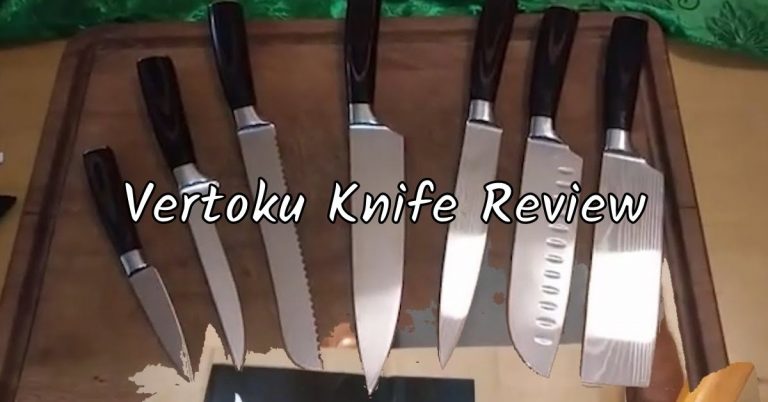Knives are an essential part of any kitchen, and there are many different types to choose from. The most popular two Japanese-style knives are the Santoku and Bunka knives. The santoku knife is a Japanese traditional kitchen knife; it is the perfect all-purpose kitchen tool. Bunka knives are an example of a Japanese specialty knife. A Bunka knife is similar in shape to the Santoku blade. But the main difference between the two types of knives is the angle at the tip of the blade.
Let’s go through this whole bunka vs santoku comparison to know more about the similarities and differences of these two types of Japanese knives.
Comparison Table: Bunka vs Santoku Knife
If you are in hurry then before going through this whole santoku vs bunka knife comparison, you can go through this quick overview table.
| Santoku Knife | Bunka Knife | |
| Blade Construction | Hand forged or Stamped | Hand forged |
| Blade Material | Stainless steel and high carbon steel | Lightweight |
| Edge | Flat or Granton | Straight |
| Bevel | Single or double bevel | Double bevel |
| Weight | Lightweight | length |
| lenght | 4-9 inch | 5-7 inch |
Top 3 Santoku Knife
| Best Overall | Second Best | Best Affordable |
What is a Santoku knife?
In Japanese, the word “Santoku” means “three uses”: slicing, dicing, and chopping. The Santoku knife is an all-around kitchen knife that can handle the majority of your cutting needs. It has a compact blade that is great for smaller hands.

The Santoku style is popular in the West and has become a very common Japanese knife shape in recent years. Santoku knives are able to slice through meat and vegetables with ease, making them perfect for home cooks who prefer dicing to mincing. For this reason, santoku knives are popular for everyday use in the home kitchen.
This popular Japanese chef’s knife is a very good multipurpose kitchen tool. It is primarily used for chopping vegetables and other foods. It is distinguished by a rectangular blade with a flat edge with a combination of blunted tip, and a narrower blade than most Western knives. If you are looking for a good Santoku knife, then going through this whole bunka vs. Santoku knife review may help you.
Top 3 Bunka Knife
| Best Overall | Best Value | Best Affordable |
What is Bunka Knife?
‘Bunka’ in Japanese means ‘culture’, making the Bunka a ‘cultural knife’. The name of bunka derives from its traditional use of making cultural cuisine in Japanese homes.

These traditional Japanese blades have been crafted in the same way for over 400 years. Bunka knives have an amazing variety of uses, especially when it comes to preparing food. Bunka blades are well known for their unique patterning and beautiful symmetry.
Many believe it comes from the fact that they were originally only used by Japanese samurai, who would wear their swords at all times. Another source believes that the name was taken from an old Japanese tradition where craftsmen would make different types of knives to serve specific purposes.
If you want to know about the top bunka knives on the market, click here to read the Best Bunka Knife Review article.
History of Bunka Knife and Santoku Knife
The origin of the Bunka knife started in the late Muromachi period. The term “Bunka” means “culture” or “civilization” in Japanese. The word “bunka knife” came later in the Edo period, when it became popular as a cooking utensil. It has been crafted in the same way for 400 years by expert craftsmen.
Santoku knives have been in use for years and have become an integral part of the Japanese kitchen. The Santoku knife was first created in the 20th century as an alternative to the Japanese vegetable cleaver Nakiri. The Santoku knife, named after the Japanese city of Sakai where it was created in the late 19th century. This has become increasingly popular in Western countries over the last few years. It’s not hard to see why they are so popular.
Full Comparison: Santoku vs Bunka
We have already gone through the basic introduction of these two types of knives in this bunka vs santoku knife comparison. Let’s go through an in-depth comparison.
Shape and Design
The Santoku is based on a Japanese vegetable cleaver called the Nakiri. The blade has a flatter cutting edge that is nearly straight from heel to tip. A gentle downward-curved spine leads to its rounded point and gives it its signature sheepsfoot blade shape.
The flat profile of the Santoku makes it great for a swift downward chop and well-suited for tap-chopping or push-cutting techniques. However, the absence of a curve on its straight-edged front blade does not allow for a rock-cutting motion. But the Santoku way of cutting is faster.

The traditional Japanese diet consisted of mainly fish and softer vegetables. So the Santoku was designed with a thinner blade and lighter weight to achieve more delicate cuts. It prioritizes finesse over overall power, making it a capable multi-use knife that is favored in lieu of a western chef’s knife in many Japanese homes as mentioned before in this santoku vs bunka knife review and comparison.
The Bunka is a Japanese knife with a straight cutting edge and a wide blade. The spine of the blade slants upward to reach the tip, which has an angled point. This type of blade was first produced in the early 20th century. Its name comes from “Bunka-to”, which means “culture sword”.

Similar to the santoku, the flat profile of the bunka makes it great for a swift downward chop and well suited for tap-chopping, push-cutting, and pull-cutting techniques.
Edge and Sharpness
Traditionally, Santoku knives feature a single bevel blade with extremely sharp edges and are perfect for creating thin slices of food. Generally, single-bevel knives tend to be sharper than double-bevel blades. However, it requires more skills in order to master the natural steer of the asymmetrical blade. Right-handed Santokus tend to pull to the left better.
Nowadays, Santoku knives are also available with double-bevel blades. Many famous knife makers, like miyabi, shun are making double-bevel santoku.
The Bunka is a Japanese chef’s knife that typically features a double-bevel blade. And generally, it resembles the signature sharp edge of Japanese knives. This Japanese-styled Bunka knife is used in the same way as a chef’s knife. It has two cutting edges, and so, as mentioned earlier in this Santoku vs. Bunda review, this can be used by both right-handed and left-handed people.
Handle
A Santoku knife handle can be categorized into two styles: the traditional Japanese “wa-handle,” or a Western style handle. The most common wa-handle shapes are the D-shape, octagonal or oval shaped. While some users prefer the ergonomic grip of a D-shaped or octagonal handle but the choice of the handle comes down to personal.
Similar to the santoku knife, Bunka knives can be classified into two types: wa-handles and Western handles. The most common shapes of wa-handles are D-shaped, oval, or octagonal. Some prefer the ergonomic grip of a D-shaped or octagonal handle, while others prefer an oval one for its similarity to the shape.
Size And Dimensions
The Bunka is a Japanese chef’s knife that is shorter in length than the standard Western chef’s knife. The blade is generally around 120–180 mm, which is about the length of an average female adult’s hand.
The Bunka is a Japanese knife with a relatively small blade that makes it easy to handle. The Bunka is smaller and lighter than a chef’s knife, so it can be used comfortably for extended periods of time.
A 165mm blade is recommended as the most suitable blade length for home cooks and professionals alike. A 165mm santoku blade has a comfortable size for handling most types of products while keeping the knife compact and easy to wield.
As mentioned earlier in this Bunka knife vs Santoku knife comparison, the Santoku is comparatively shorter and thinner than a standard Western chef’s knife. It comes with most blade lengths between 130 and 200 mm, which is about the length of an average adult’s hand. Its compact length, combined with the thinness of the blade, makes it smaller and lighter than a Western knife.
For home cooks, 165mm is the recommended length of the blade. It is a sufficient size for handling most types of produce while staying small enough to be easy to handle.
What is a Santoku knife best for?
The Santoku knife is a Japanese kitchen knife that, true to its name, is best for chopping, dicing, and mincing food such as meat, fish, and vegetables. The sharp blade combined with the Santoku’s straight cutting edge makes it the ideal tool for executing swift, clean cuts in an up-and-down motion or using a tap-chop.

The flat profile of the Santoku knife is complemented by the thin and razor-sharp blade. That makes it great for cutting meat, seafood, cheese, fruits, and vegetables. The wide blade of the santoku is handy for scooping food off the cutting board.
The Santoku originated in Japan as a general-purpose kitchen knife. It is similar to the western chef’s knife, but has a straighter edge and is more versatile with its ability to slice, dice, and cut meat. The Santoku is easy to sharpen and holds an edge longer than other knives.
Moreover, it easier to handle , especially for those with small hands.
What is a Bunka Knife best for?
The Bunka knife is similar to the Santoku knife in that it’s best for chopping, dicing and mincing food. Both knives have a sharp, thin blade and a straight cutting edge. The Bunka can also be used for executing swift clean cuts in an up-and-down motion or using a tap-chop or push-cut.

The Bunka has a tall and flat profile with an angled’reverse tanto’ tip. The sharp tip makes the knife ideal for delicate, precision cutting. The wide blade of the Bunka is useful for scooping food off of the cutting board.
A Bunka is a double-beveled knife, but it maintains the signature sharp edge of Japanese knives. In comparison to Western chef’s knives, Bunka blades are ground at an angle of 10–15 degrees because they can be honed to a sharper state.
Because the Bunka knife is usually shorter in length compared to a Western chef knife, it is considerably lighter and easier to handle, as described earlier in this Bunka vs. Santooku review. Especially for those with small hands or those with a smaller and limited workspace, bunka knives are really helpful.
What is the popular Bunka Knife brand?
The Bunka knife is an everyday kitchen knife that originated in Japan. Traditional blacksmiths, there still forge Bunka knives by hand, but some Japanese manufacturers have started to produce their own versions of the knife. Some of the most popular Bunka knife brands are:
What are the popular Santoku Knife Brand?
Santokuves are now made by a variety of Japanese and Western manufacturers,, including:

- Yoshihiro
- Tojiro
- Gesshin Uraku
- Masamoto
- Mercer Culinary
- Shun
- Wusthof
- Zwilling J.A. Henckels
- Victorinox
- Global
- Miyabi
FAQ
1. What is the best Bunka knife?
The Enso Vg10 HD Bunka knife is a proper combination of quality and beauty. If you want to choose a high-quality Bunka knife, then it can be a great choice. And enso sg2 is a more high-end option.
2. What is the best Santoku knife?
If you are looking for a high-end Santoku knife, then Shun Premier Santoku is a great option to go with. There is another choice of shun, which is shun classic santoku.
Conclusion
If you have gone through this whole bunka vs santoku article, you must have got a clear idea about santoku and Bunka knife. And you know the differences between a Bunka knife and a santoku knife. Both of the knives are multipurpose knife but the main difference is in the tip and design. It’s time to make a decision that which type of blade is perfect for your needs
Other Comparisons:







